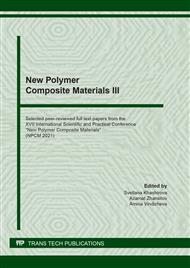[1]
Weng, F., Liu, X., Koranteng, E., et al., Structure and properties of a compatible wood-plastic composite prepared by using poly(butylene succinate)-based polyurethane prepolymer. Polymer Composites, 2019. 40(12) 4694-4703.
DOI: 10.1002/pc.25337
Google Scholar
[2]
Wang, S., Liu, Z., Zhang, L., et al., Strong, detachable, and self-healing dynamic crosslinked hot melt polyurethane adhesive. Materials Chemistry Frontiers, 2019. 3(9) 1833-1839.
DOI: 10.1039/c9qm00233b
Google Scholar
[3]
Fan, W., Zhang, Y., Li, W., et al., Multi-level self-healing ability of shape memory polyurethane coating with microcapsules by induction heating. Chemical Engineering Journal, 2019. 368 1033-1044.
DOI: 10.1016/j.cej.2019.03.027
Google Scholar
[4]
Mirmohseni, A., Akbari, M., Najjar, R., et al., Self-healing waterborne polyurethane coating by pH-dependent triggered-release mechanism. Journal of Applied Polymer Science, 2019. 136(8) 47082.
DOI: 10.1002/app.47082
Google Scholar
[5]
Deng, Y., Dewil, R., Appels, L., et al., Reviewing the thermo-chemical recycling of waste polyurethane foam. Journal of Environmental Management, 2021. 278 111527.
DOI: 10.1016/j.jenvman.2020.111527
Google Scholar
[6]
Gama, N., Godinho, B., Marques, G., et al., Recycling of polyurethane by acidolysis: The effect of reaction conditions on the properties of the recovered polyol. Polymer, 2021. 219 123561.
DOI: 10.1016/j.polymer.2021.123561
Google Scholar
[7]
Zhang, Y., Broekhuis, A.A., and F. Picchioni, Thermally Self-Healing Polymeric Materials: The Next Step to Recycling Thermoset Polymers? Macromolecules, 2009. 42(6) 1906-1912.
DOI: 10.1021/ma8027672
Google Scholar
[8]
Chang, K., H. Jia, and S.-Y. Gu, A transparent, highly stretchable, self-healing polyurethane based on disulfide bonds. European Polymer Journal, 2019. 112 822-831.
DOI: 10.1016/j.eurpolymj.2018.11.005
Google Scholar
[9]
Liang, Z., Huang, D., Zhao, L., et al., Self-healing Polyurethane Elastomer Based on Molecular Design: Combination of Reversible Hydrogen Bonds and High Segment Mobility. Journal of Inorganic and Organometallic Polymers and Materials, 2021. 31(2) 683-694.
DOI: 10.1007/s10904-020-01697-1
Google Scholar
[10]
Liu, J., Ma, X., Tong, Y., et al., Self-healing polyurethane based on ditelluride bonds. Applied Surface Science, 2018. 455 318-325.
DOI: 10.1016/j.apsusc.2018.05.159
Google Scholar
[11]
Coope, T.S., Turkenburg, D. H., Fischer, H. R., et al., Novel Diels-Alder based self-healing epoxies for aerospace composites. Smart Materials and Structures, 2016. 25(8) 084010.
DOI: 10.1088/0964-1726/25/8/084010
Google Scholar
[12]
Platonova, E.O., Vlasov, E., Pavlov, A. A., et al., Self-healing polyurethane based on a difuranic monomer from biorenewable source. Journal of Applied Polymer Science, 2019. 136(33) 47869.
DOI: 10.1002/app.47869
Google Scholar
[13]
Shahidzadeh, M., Khansari, V. Z., Ramezanzadeh, B., et al., Self-healing dual cured polyurethane elastomeric coatings prepared by orthogonal reactions. Progress in Organic Coatings, 2020. 140 105503.
DOI: 10.1016/j.porgcoat.2019.105503
Google Scholar
[14]
Wei, Y., Du, X., Ma, X., et al., Synthesis and self-healing property of polyurethane modified with three-furyl diol. Polymer Bulletin, 2017. 74(9) 3907-3922.
DOI: 10.1007/s00289-017-1920-7
Google Scholar
[15]
Gandini, A., Carvalho, A., Trovatti, E., et al., Macromolecular materials based on the application of the Diels–Alder reaction to natural polymers and plant oils. European Journal of Lipid Science and Technology, 2018. 120(1) 1700091.
DOI: 10.1002/ejlt.201700091
Google Scholar
[16]
Karami, Z., Zohuriaan-Mehr, M. J., Kabiri, K., et al., Bio-based thermoset alloys from epoxy acrylate, sesame oil- and castor oil-derived resins: Renewable alternatives to vinyl ester and unsaturated polyester resins. Polymers from Renewable Resources, 2019. 10(1-3) 27-44.
DOI: 10.1177/2041247919863633
Google Scholar
[17]
Ding, J.H., Peng, W. J., Luo, T., et al., Study on the curing reaction kinetics of a novel epoxy system. Rsc Advances, 2017. 7(12) 6981-6987.
DOI: 10.1039/c6ra25120j
Google Scholar
[18]
Dzunuzovic, J., Pergal, M., Jovanovic, S. M., et al., Synthesis and swelling behavior of polyurethane networks based on hyperbranched polymer. Hem.,ind, 2011. 65(6) 637-644.
DOI: 10.2298/hemind110902071d
Google Scholar


